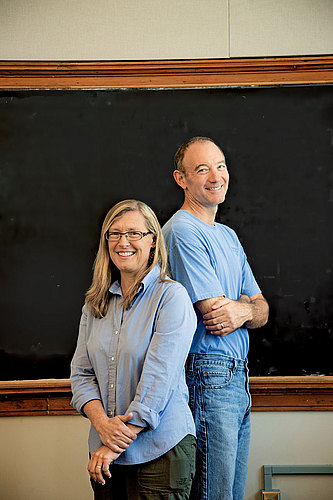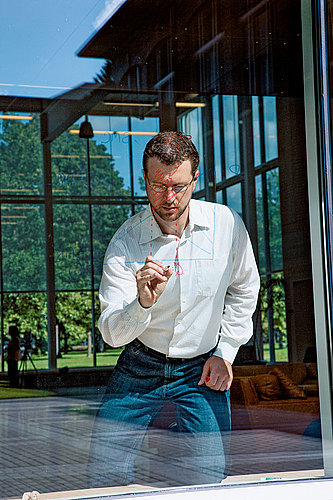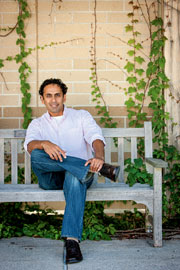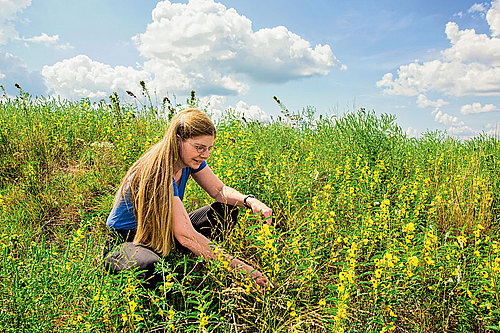New research and emerging technologies are inspiring educational innovation and improving how students learn in college classrooms.
Stand and deliver!
For hundreds of years, the lecture—derived from the medieval practice of reading to students from an original source—was the primary activity in college classrooms around the world. But times have changed. In fact, many professors now believe that delivering content to their students via lecture is among the least effective uses of their class time.
“The currency of the realm in the liberal arts is ‘high-touch’ class time where students interact with their classmates and professor,” says Paula Lackie, an academic technologist at Carleton. “The idea is to deliver the basic building blocks of content to students outside of class and maximize personal interaction focused on this material during class.”
Known as the “flipped classroom,” this practice has increased since it emerged in 2007 due to a confluence of new knowledge about effective student learning and advances in technology. In this model, students can listen to a recorded lecture on their own time and at their own pace, then hone what they’ve learned under the guidance of the professor during class time. The professor’s role has changed from a sage on the stage to that of a tutor or coach who helps each student become a better learner.
Class time not devoted to lecturing can be used instead to discuss how students arrived at their answers and why some students’ answers may vary. Such discussions help students develop metacognition (awareness and understanding of one’s own learning process), which has long been recognized as a key contributor to excellence in learning. Similarly, professors have time to explore other learning strategies, such as group or team learning, experiential learning, civic engagement, and field trips.
“Our pedagogy always has been about hands-on, experiential learning,” says Mary Savina ’72, the Charles L. Denison Professor of Geology. “We gave up on trying to drill content a long time ago; it just isn’t an effective use of our time.”
Emerging Research and Resources
Empirical studies are uncovering the teaching methods, course designs, and study habits that maximize learning and improve graduation rates. Students aren’t the only ones who stand to gain by this research; teachers find that adopting evidence-based recommendations makes teaching more interesting, as well as more effective.
“Academics are excited about new developments in teaching and learning,” says Regan Gurung ’91, professor of human development and psychology at the University of Wisconsin–Green Bay. A winner of several teaching awards, Gurung has written or edited numerous books and papers related to teaching and learning, including the 2012 book Evidence-Based Teaching for Higher Education. He notes that many changes in the classroom are so new that their effectiveness is still being scrutinized.
“Along with new teaching methods and technologies comes the emergence of more pedagogical research—sound scholarship that takes a hard look at teaching and learning, using control groups and a peer-review process, and doesn’t just rely on anecdotal evidence and intuition,” he says.
“Research has shown that many things we considered to be learning aids—such as key terms and boxed information in traditional textbooks—actually don’t work. The more students use them, the worse their exam scores, possibly because these so-called ‘learning aids’ divert their attention from other important information. We need evidence-based research to help guide us as we look at new pedagogies and new technologies.”
Gurung also is excited to see more faculty members working with instructional designers, teaming up with academic support personnel, and utilizing resources at their institutions, such as Carleton’s Perlman Center for Learning and Teaching (LTC). But the biggest challenge educators face might be just navigating the ever-changing landscape.
“There’s so much to work with and so many ways we can help students learn,” he says. “We have to determine what is best for our purpose.”
Digital Innovations
“Not enough people look for evidence before they change how they’re teaching in the classroom,” says Regan A. R. Gurung ’91, the Ben J. and Joyce Rosenberg Professor of Human Development and Psychology at the University of Wisconsin in Green Bay. “Too often we take for granted that new technologies or methods are better; we need to put them under the research microscope and be sure they work before we bring them to the classroom.”
Thanks to technological advances, educators are developing teaching methods that are effective, challenging, and enjoyable for students with a variety of learning styles. In fact, the use of interactive technologies throughout the curriculum is the biggest change in teaching, learning, and research. It’s important to note, however, that educational technologies are meant to facilitate delivery, not drive the instruction.
They include:
Devices: For years, students usually needed only a pencil and a notebook for class. In today’s classroom, however, students often are outnumbered by technological devices, including computers (laptops and tablets), document cameras, multimedia projectors, and even smartphones. Faculty members team up with technologists to identify the best options for specific curricular needs, requiring some trial and error to achieve the best results. Simple technologies often are more effective than sexy ones, says Lackie, who notes that pencil and paper is still the best choice for some purposes.
In other cases, newer devices can significantly aid the flow of a class. For example, teachers can project pop quizzes on a screen and have students select their answers using individual TV-remote style devices, known colloquially as “clickers.” When the results pop up anonymously on the screen, teachers can tell immediately if students are grasping the material and either offer clarification or move on to new material.
As tablets become more affordable and useful, their presence is increasing in educational settings. Research and advisory firm Forrester predicts that tablets will become the preferred primary device for millions of people and forecasts that 760 million tablets will be in use globally by 2016.
Digital textbooks: You may have lugged textbooks to class, but today’s students often access their course material digitally on a mobile device, e-reader, laptop, or tablet. In a survey of more than 500 currently enrolled college students, Wakefield Research found that students are more likely to bring a laptop (51 percent) than a print textbook (39 percent) to class, with 53 percent frequently reading e-textbooks. Inside Higher Ed and the Babson Survey Research Group recently surveyed more than 4,500 faculty members about technology-driven trends and found that more than one-third of faculty members regularly assign books that are available in both e-textbook and traditional formats, and 65 percent said they were excited about e-textbooks and e-resources replacing traditional print textbooks.
Online digital textbooks are replete with interactive study aids. For example, scores to online quizzes are translated quickly into an individually tailored study plan designed to fill the gaps in a student’s knowledge and understanding.
Web-based resources: The Internet provides students and teachers with unparalleled access to free information both in and out of the classroom.
“Google Earth is a miracle for geologists,” says Savina. “My research is primarily about interpreting landforms—and Google Earth gives me faster access to high-resolution images than I have ever had before. However, as is the case with results from any search engine, it’s still important to carefully evaluate these resources.”
Online learning communities: Since 2002 the number of U.S. college students who take at least one online course per year has risen from 1.7 million to 6 million, according to the Chronicle of Higher Education.
Universities like Carnegie Mellon, Stanford, Harvard, and MIT are experimenting with massive open online courses (MOOCs), in which materials and instruction are delivered freely over the Internet to users both on campus and around the world. MOOCs offer on-campus students online tools that reinforce their classroom and laboratory experiences, allow individual teachers to reach hundreds of thousands of motivated students who lack access to elite institutions, and enable virtual communities of learners to produce content about a common topic. MIT is making its open-source software infrastructure available to other educational institutions for use in developing their own online courses.
Most MOOCs are free, but students who want to demonstrate content mastery often can receive an informal certificate of completion for a modest fee (although it is not the same college credit that these institutions award to students enrolled in traditional courses).
Although not every college offers online courses, most have online course management or learning management systems in place, and educators can use them to manage some or all aspects of their courses. Carleton supports Moodle (originally an acronym for Modular Object-Oriented Dynamic Learning Environment), an open-source, web-based tool that teachers in more than 45,000 learning communities around the world use to deliver content to students through recorded lectures, readings, quizzes, exercises, newsfeeds, and other materials. Professors can also accept, grade, and return assignments digitally; provide web versions of syllabi; hold virtual discussions; and much more.
“At Carleton, faculty members opt to use Moodle in roughly half the courses,” says Lackie.
Keeping Up at Carleton
With so many changes afoot in teaching and learning, it’s difficult for any one teacher—or institution—to keep pace. Yet it’s fair to say that Carleton is doing better than most. The College has demonstrated an ongoing commitment to providing faculty members with wide-ranging curricular support services through resources such as the LTC, the Science Education Resource Center, Academic Technologies, the Gould Library, and Information Technology Services.
Several campus-wide initiatives launched in the past 5 to 10 years, such as Visualizing the Liberal Arts and Quantitative Inquiry, Reasoning, and Knowledge, help keep Carleton’s curriculum vibrant and current. Along with other initiatives, such as Writing Across the Curriculum (which dates back to the 1970s), these programs offer faculty members annual grants to support curricular improvement. What’s more, Carleton has an impressive array of innovative, technology-rich facilities—such the Weitz Center for Creativity, which opened in fall 2011, the Language and Dining Center, and the Center for Math and Computing.
But when it comes to teaching and learning, Carleton’s most important asset surely resides in the passion of its faculty and staff. “Sometimes we’re not sure if [new pedagogies] represent progress or not, says religion professor Louis Newman, the current director of the LTC. “But we are confident that our faculty is extremely good—and very committed to teaching.”
Newman points out that each year, 60 to 70 percent of Carleton faculty members typically participate in one or more of the LTC’s noon lunch events (held weekly during the term) and winter break workshops. At a recent lunch event, three Carleton professors gave examples of how they’ve incorporated screencasting and video podcasting into their courses. And, each day, Carleton faculty members bring what they learn about education into the classroom. (See sidebars, below.)
Carleton has been conducting its own research, which over the past couple years has included a study on curricular uses of visual materials and a six-month study on curricular and research support at the College, intended to identify existing support services and challenges, help eliminate redundant efforts, and focus expertise on current needs.
The College is using the research to inform the design and renovation of facilities, as well as the hours, staffing, and location of academic support centers. “Curricular and research support at Carleton should be designed both to encourage student engagement with expertise on campus and to foster independent pursuit of knowledge,” says Andrea Nixon, Carleton’s director of curricular research and support.
In the meantime, Savina is convinced that as new knowledge about learning and teaching continues to evolve, Carleton’s faculty members will keep current. “There’s an eagerness among Carleton faculty members to make their teaching as excellent as possible,” she says. “They’re always looking for ways to improve what they do in the classroom.”
Assasinating Nero
 When Carleton classics professors Clara Hardy and Chico Zimmerman teach the section of “Classics 110” on Neronian Rome, almost inevitably, one or more students ask: “Why didn’t they just assassinate Nero?”
When Carleton classics professors Clara Hardy and Chico Zimmerman teach the section of “Classics 110” on Neronian Rome, almost inevitably, one or more students ask: “Why didn’t they just assassinate Nero?”
Why, indeed?
“Nero did some pretty insane things,” says Hardy. Like ordering the execution of his own mother and burning captured Christians at night to provide light in his gardens. “And it’s almost inconceivable to students how
he could have stayed in power.”
To help them understand what it was like to live in Nero’s autocracy, in 2008 she and Zimmerman, the Hazel Lillian Amland Grose Professor of Classics, worked with Carleton’s Information Technology Services to create a game called “Neropolis.”
Modeled loosely on the popular Carleton undergraduate game Assassins (a last-person-standing-wins game in which Nerf gun–slinging students attempt to carry out mock assassinations), Neropolis uses a virtual environment to immerse students in the life of Neronian Rome.
Each student is assigned a persona, such as senator, soldier, assassin, Nero sympathizer, or spy. They create their own profile on a Facebook-like wall and use images from ancient coins or sculptures as their portraits.
Unbeknownst to the students, an anonymous faculty member assumes the role of Nero, which allows him or her to inject more history into the game. One year, a colleague got so immersed in the role of the tyrannical Roman emperor, he even wrote poetry (Nero fancied himself a poet) and posted it on his wall.
To successfully assassinate Nero, students must identify three co-conspirators and all four of them must post “Death to Nero” on their personal walls within two minutes of one another. This can be much more difficult than it might seem, since the would-be assassins don’t know which students are sympathetic to their cause—and who is a spy or member of Nero’s praetorian guard. Although the game runs for just two weeks, it has a significant effect on the students.
“Very quickly, they learn what it’s like to live in an autocracy, where there’s a secret service—essentially—monitoring everything you do,” says Hardy. “More importantly, it involves students at a much higher level than lectures and class discussions alone and pulls in some students who weren’t engaged at all. Neropolis—which is what Nero wanted to call Rome—is a game that brings a lot of fun to the classics.”
Research by the Masses
One of the most powerful learning experiences a student can have is to work side-by-side with a faculty member on a real-world research project. It builds understanding and develops a student’s critical thinking abilities in ways nothing else can. Unfortunately, it’s not feasible to provide all undergraduates with traditional research opportunities.
In her “Biology 241 Genetics Lab” (a companion to “Biology 240 Genetics”), Susan Singer believes she has come up with a way to recreate that experience for an entire classroom of undergraduates. Singer, who is the Laurence McKinley Gould Professor of Biology and Cognitive Science, is a recognized authority on science education. She recently chaired the National Research Council’s committee that authored Discipline-based Education Research: Understanding and Improving Learning in Undergraduate Science and Engineering.
“This lab work captures the advantages of doing a research project with a faculty member—48 students at a time,” says Singer. The key to immersing so many students in their own real-world research project within the confines of a typical science class is to provide them with what Singer calls the “scaffolding”—sophisticated online tools and other resources, including a huge genomics database, that guides students through the process of identifying and resolving complex problems in genomics research.
“Our students pose—and answer—these questions the same way a biologist would,” says Singer. For example, students have studied why the prairie legume Chamaecrista fasciculata (a focus of Singer’s research) flowers earlier in Minnesota than it does in more southern climes. Singer provides them with sample plants grown under a variety of conditions, such as long day, short day, warm temperatures, and cool temperatures.
“They’re able to do their own research—like isolating the RNA from the plant, mapping out the gene sequence, and identifying how both genetic and environmental factors play into the differences among these plants,” says Singer. “Biology is incredibly exciting; the best way to convey that to students is by having them do the work of real-world biologists.
“What’s more, we’ve found that this approach really works,” she says. “We use a critical thinking rubric to analyze their first paper and their final paper; it shows that the students’ critical thinking skills increase substantially during the term. In many ways, the gains students make in this class are similar to the gains from a one-on-one research project with a faculty member.”
Tightening the Feedback Loop
 Like most Carleton faculty members, Aaron Swoboda ’01 spends a lot of time and energy trying to incorporate new methods of learning and teaching into his classes. Swoboda, who holds a joint appointment in economics and environmental studies, follows a number of education blogs, attends conferences, and participates in as many workshops as he can at Carleton’s Perlman Center for Learning and Teaching. He has begun focusing more of his teaching energies on what he likes to call “tightening the feedback loop.”
Like most Carleton faculty members, Aaron Swoboda ’01 spends a lot of time and energy trying to incorporate new methods of learning and teaching into his classes. Swoboda, who holds a joint appointment in economics and environmental studies, follows a number of education blogs, attends conferences, and participates in as many workshops as he can at Carleton’s Perlman Center for Learning and Teaching. He has begun focusing more of his teaching energies on what he likes to call “tightening the feedback loop.”
“Rather than giving a lecture and a homework assignment one week, then grading it and giving it back a week or two later, I’m trying to tighten that loop by creating more interaction and active learning in the classroom,” says Swoboda.
The idea sounds simple, but it takes a lot of work to pull it off. Swoboda uses combinations of new teaching tools and methods. He has videotaped many of his lectures for students to view prior to class. He uses a team-based learning approach, in which groups of students answer a question, compare their answers, and try to figure out why they came up with different results.
When he identifies gaps in knowledge during classroom discussion, he follows up with a mini-lecture on the topic. If Swoboda thinks the spontaneous mini-lectures cover significant information, he creates follow-up recordings so students can review that information on their own time. Swoboda also encourages his students to use Google Docs, Skype, and web-conferencing software when working on group projects outside the classroom.
“By working together in teams and having more classroom discussions and interactions, I can identify the mistakes students are making, correct them much earlier, and help them better understand why we’re doing the things we’re doing,” says Swoboda.
Web Extra: Read reports on Carleton’s curricular and research support.



